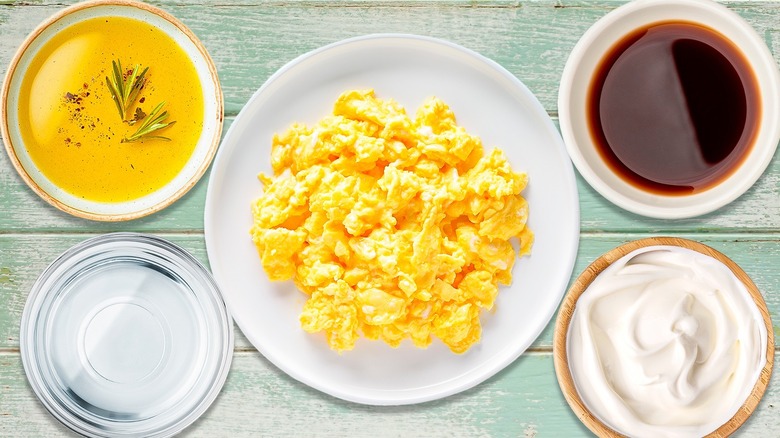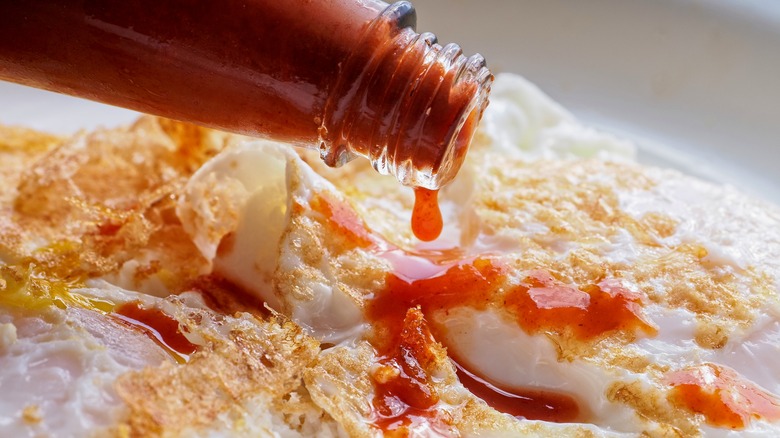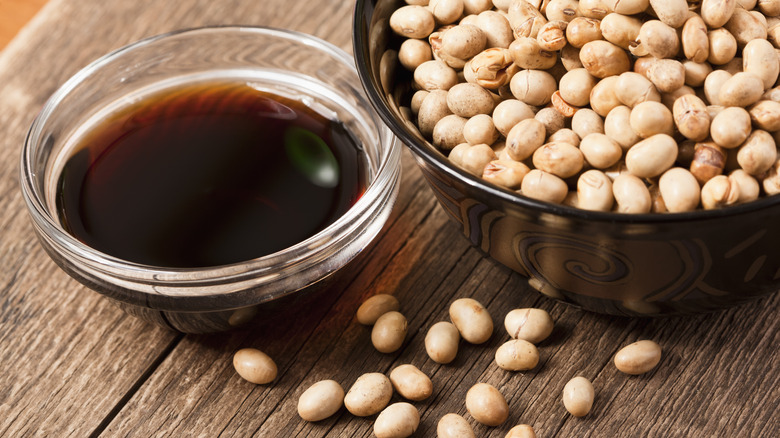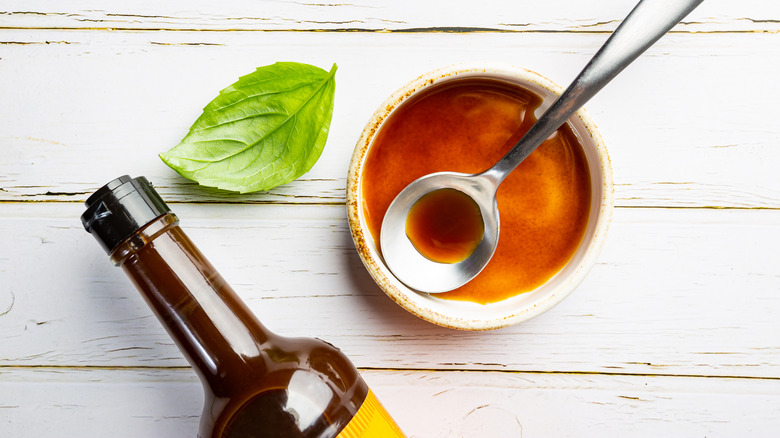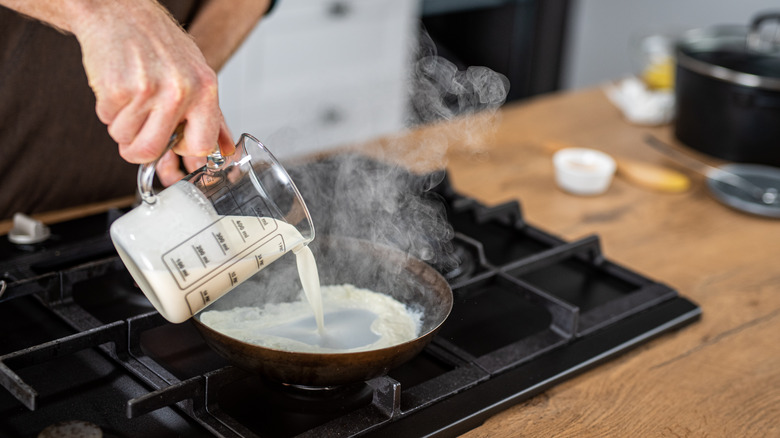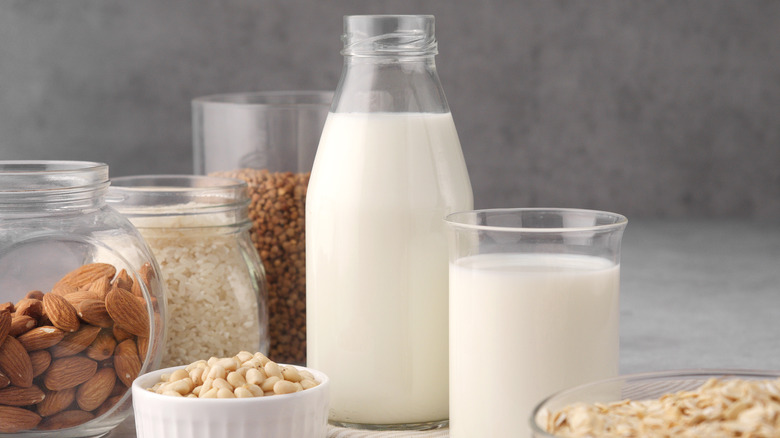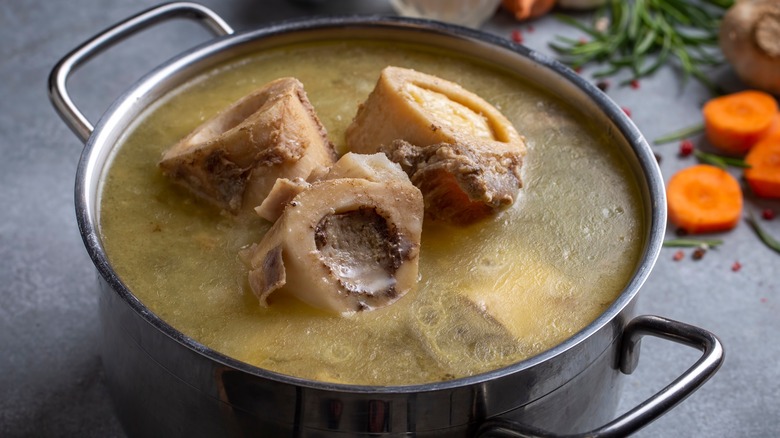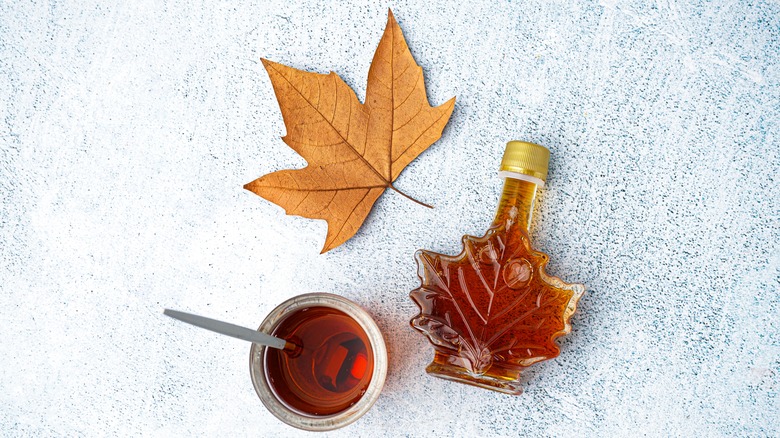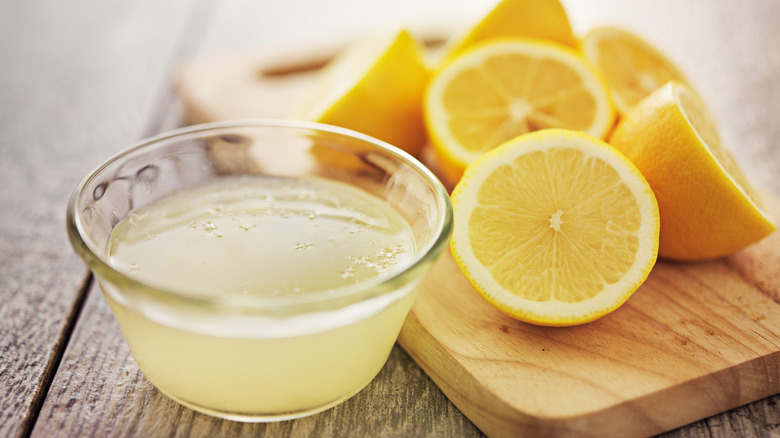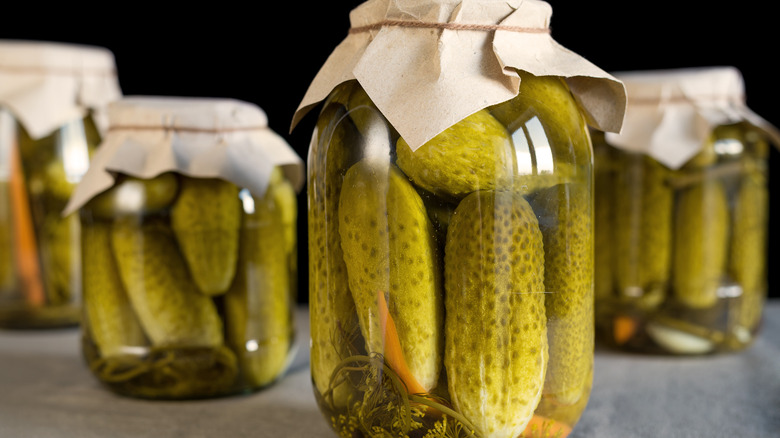11 Liquid Ingredients That Will Make Your Scrambled Eggs So Much Better
For many, scrambled eggs are the perfect breakfast dish, whether you enjoy it standalone or as a side item. Scrambled eggs are quick to make, filling, tasty, and versatile. They can be enjoyed alongside your breakfast protein of choice, in a sandwich, or stuffed inside a breakfast taco or burrito. That said, there's no reason to stop there. Elevating the humble and classic dish of scrambled eggs to new heights is an art form every breakfast enthusiast should master. While the iconic combination of eggs, salt, and pepper can yield a satisfying dish on its own, introducing a variety of different liquid ingredients can help take your scrambled eggs to a whole new level of decadence.
From milk to water to different sauces, we'll explore a myriad of liquid additions that can help to transform this basic dish. From the familiar to the unexpected, these additions will infuse your eggs with richness, new flavor, and a dash of creativity to provide you with a truly unique take on your favorite breakfast. Whether you prefer the creamy richness of dairy or the bold kick of hot sauce, each addition brings a one-of-a-kind character to your morning ritual.
1. Hot sauce
For a more daring and adventurous kick at the breakfast table, hot sauce is the secret weapon that's ready to catapult scrambled eggs from bland to bold and unforgettable. Whether you opt for the vinegary punch of Tabasco or the spicy and garlicky spin of Sriracha, a few daring dashes are all it takes to upgrade your morning side dish. You can even mix a bit of Buffalo sauce in with your eggs for a truly unique breakfast.
The smoothness of creamy eggs and the fiery spice of hot sauce create a dynamic flavor and texture profile that brings real complexity. The best part is you can tailor your take by adding as little or as much hot sauce as you want. To incorporate hot sauce into your scrambled eggs, simply add a few dashes to the whisked eggs before cooking. You could also simply drizzle it over the finished dish. The result is a breakfast that goes beyond the ordinary.
2. Soy sauce
Inspired by the nuanced flavors of many types of Asian cuisine, the umami-rich depth of soy sauce is a transformative addition to your scrambled eggs. The savory notes of soy sauce work well to complement the richness of eggs, creating a dish that is not just savory but complex and utterly satisfying.
This technique, used by culinary stars such as Shirley Chung, the runner-up of "Top Chef" Season 14, cookbook author Joy Wilson, and "Top Chef" alum Stephanie Izard, has gained recognition for its ability to redefine the very essence of scrambled eggs. The brilliance of soy sauce lies in its simplicity. A mere drizzle is all it takes to take a dish to new heights.
Soy sauce not only amplifies the savory taste of eggs but can also be a clever substitute for salt, adding depth without overpowering the delicate nature of scrambled eggs. It's a testament to the fact that the simplest additions, inspired by global culinary traditions, can make a significant impact on your cooking.
3. Worcestershire sauce
When it comes to flavor-enhancing condiments, Worcestershire sauce stands out as an often underutilized ingredient, especially at breakfast. Yes, Worcestershire is great in marinades and savory dishes, but did you know that you can also use it to elevate your scrambled eggs? A few drops of this complex condiment introduce a one-of-a-kind depth of flavor that makes each bite truly unique. The umami notes of Worcestershire sauce harmonize with the eggs, resulting in a breakfast dish that is savory, robust, and utterly satisfying.
Worcestershire sauce's ability to add depth and complexity stems from its unique combination of ingredients, including anchovies, tamarind, and a variety of spices that transform your scrambled eggs. Top chefs and home cooks alike have embraced this technique, recognizing Worcestershire sauce as a versatile addition that takes flavor to another level. Worcestershire sauce can also be used as a finishing touch on cooked scrambled eggs.
4. Liquid dairy products
There are a variety of liquid dairy products that can help you achieve beautifully creamy eggs. The options range from milk and cream to half-and-half and even evaporated milk. If it's dairy and it pours, it's fair game unless it's a sweetened creamer. That said, we think your best option is cream if you have it.
The liquid in dairy products like milk, cream, and half-and-half helps thin out the proteins in the eggs to make them fluffier. However, if tender eggs are your goal, you should be careful to cook the eggs slowly over low heat for the best results, like in Gordon Ramsay's egg-scrambling technique. If you cook them too quickly or over too high a heat, you'll likely end up with a watery mess when the dairy products separate from the eggs.
To avoid eggs that are too wet, use no more than a tablespoon of the liquid dairy product for each egg. Even a half tablespoon per egg is often enough. While most scrambled egg recipes involve whisking the liquid dairy product into the egg before scrambling, there are other techniques you may want to consider. One involves bringing a liquid dairy product like cream to a simmer in the skillet before adding beaten eggs. A French technique popularized by Auguste Escoffier in his 1907 book, "A Guide to Modern Cookery," involves adding cold cream and butter at the end of the cooking process.
5. Non-dairy milks
If liquid dairy products aren't good options for you — perhaps because of lactose intolerance or dairy allergies — you can always use non-dairy milk. There are a lot of choices out there, like soy, almond, oat, and rice milk, to name just a few. The resulting scrambled eggs probably won't quite have the same texture and flavor as eggs made with dairy, but it's still a good option if you're looking for something creamy to add to your eggs.
Be sure you pay attention to the flavor of your non-dairy milk. Many brands contain sugar or flavorings like vanilla. If you're not keen on the idea of sweet vanilla eggs for breakfast or brunch, choose a non-dairy milk that's unsweetened and unflavored. Another consideration is the flavor neutrality of your non-dairy milk. For example, using oat milk might infuse eggs with an oatmeal-like flavor. Likewise, coconut milk would likely make the eggs taste like coconuts, which may or may not be the flavor you want. Another consideration: the higher the fat content of your non-dairy milk, the more richness it will add to scrambled eggs.
Scrambling eggs with non-dairy milk is fairly straightforward, as you'll use the same amount of non-dairy milk as you would dairy milk in your scrambled eggs recipe. Also, as with dairy milk, scramble non-dairy milk eggs over low heat to prevent the liquid from separating and keep the eggs nice and fluffy.
6. Broth
Just like with adding soy sauce, adding broth to scrambled eggs provides a hit of rich umami flavor and saltiness. If your broth is salty already, you may not even need to add extra sodium to your scrambled eggs. The outcome will be fluffy like eggs made with water and dairy products. However, they will likely be more dense than if you used water alone.
The type of broth you use is up to you. We've seen recipes for scrambled eggs with chicken broth as well as those made with bone broth, though there's no reason you couldn't use vegetable broth or whatever your favorite broth might be. If it's broth you've made yourself, first filter it and skim the fat off the top — unless you feel like experimenting with meat fat in your eggs, of course. Don't add more than a tablespoon of broth to your eggs.
There are a couple of ways to incorporate broth into your scrambled eggs. Some cooks like to whisk the broth straight into the egg mixture before scrambling. You may also pour your egg mixture into simmering hot broth in your skillet, which may be a little more dramatic when you're cooking larger quantities of scrambled eggs.
7. Maple syrup
Maple syrup is a liquid you might not have considered adding to your scrambled eggs before, but if you're a fan of McGriddles, this might be exactly the scrambled egg flavor you never knew you'd love. Maple syrup adds a distinct flavor to your eggs that can give you a sweet start to your day. While it's best to use real maple syrup, the fake type will work as well, although the flavor will be less interesting and it tends to be thicker.
While you're welcome to experiment with how much maple goodness you want in your eggs, a good place to start is to mix in about one teaspoon of maple syrup per egg. If you want your eggs sweeter, of course, you'll need more. You may also want to add water, a liquid dairy product, or non-dairy milk along with the maple syrup to keep it from getting too thick.
If you'd like, you can also drizzle maple syrup on top after the eggs are done. That extra syrup makes this a great opportunity for dipping your toast, pancakes, bacon, or any other breakfast food you like with maple syrup.
8. Vinegar
If the idea of adding vinegar to scrambled eggs has you feeling doubtful because of vinegar's sharp flavor, don't worry. A bit of vinegar can brighten the flavor of your dish. What's more, because the ph of eggs typically ranges from neutral to mildly alkaline, they can help balance the acidity in vinegar, making the final taste more subtle than you might think. That acid in vinegar also allows proteins to come together without so much heat, making eggs tender at the lower temperatures that are ideal for scrambling eggs.
We suggest you start with just a tiny splash of vinegar, or about a teaspoon for every six eggs. In other words, a single egg only needs a drop or two of vinegar.
If you have a whole array of vinegars at your disposal, it might be difficult to decide which one to use. While you might want to try white vinegar to start to be on the safe side, feel free to branch out with other types as well. The slightly fruity notes of wine and sherry vinegar may work well with eggs. Rice vinegar works for Asian-style scrambled eggs with add-ins like green onions. Scrambled eggs can even work with a more robust balsamic vinegar if you also include more strongly-flavored ingredients such as red onions or sausage.
9. Citrus juice
Much like vinegar, the acids in citrus juice make the protein structures in eggs a little less tight, allowing them to fluff up more. This culinary trend was all the rage in 1600s France, where the practice of adding tart citrus juice to scrambled eggs may have been the inspiration behind lemon curd. However, while adding lemon juice to eggs remains popular, juice-infused eggs aren't meant to be sweet. When you add a bit of orange juice to your scrambled eggs, you won't necessarily taste the orange juice on its own.
When using citrus juice, remember to use a low cooking temperature for the best results. If scrambling the egg with the citrus juice incorporated into the eggs, use about a half teaspoon of orange juice per egg — its acidity isn't as strong as lemon or lime juice. With lemon or lime juice, use just a small squeeze, although we've seen some recipes that used up to three-fourths of a teaspoon per egg. Another way to use citrus juice here is to add a squeeze of lemon or lime juice to the top of scrambled eggs right before they hit the table.
10. Dill pickle juice
You can do so many things with leftover pickle juice that it's no surprise you can add it to scrambled eggs. If you're a dill pickle lover, pickle juice scrambled eggs might be the next greatest thing you try. Consider the recent social media trend where cooks added pickle juice to fried eggs at the last minute for a flavor boost. Here, just like with the other acids we've mentioned, a dash of pickle juice will help make your eggs fluffier than usual through the help of chemistry.
Go ahead and make your scrambled eggs as usual, only stirring pickle juice into the egg mixture. Serious pickle fans might want to go with as much as a tablespoon of pickle juice per egg, though feel free to start with a smaller amount if that seems excessive. If you still have some pickles left floating around in the juice, experiment with adding some diced pickles to the eggs, too.
11. Club soda or seltzer water
Another option you've likely never thought of for making pillowy eggs is to add club soda or seltzer water. Restaurant cooks have even been known to use plain carbonated water from the soda fountain to make their eggs. The bubbles are key in achieving an especially soft texture. As the fizzy air bubbles in the carbonated water expand and then burst under heat, the structure inside the cooking eggs is left with empty space. If you want the lightest and airiest scrambled eggs, use fresh, fizzy club soda rather than some that's gone flat in the fridge.
Since club soda doesn't have a flavor, it will only change the texture of your eggs, assuming you use unflavored and unsweetened club soda or seltzer water. Because the CO2 in the bubbles disperses during cooking, there's no need to worry that it will make the eggs taste carbonated. This is a good option if you're looking for pillowy eggs but aren't keen on the idea of changing the flavor by adding an acid.
To make club soda scrambled eggs, simply add about half of a tablespoon of club soda or seltzer water per egg before scrambling. The steam that escapes makes the eggs a little extra moist, so use a scant amount of soda or seltzer if you prefer drier eggs.
